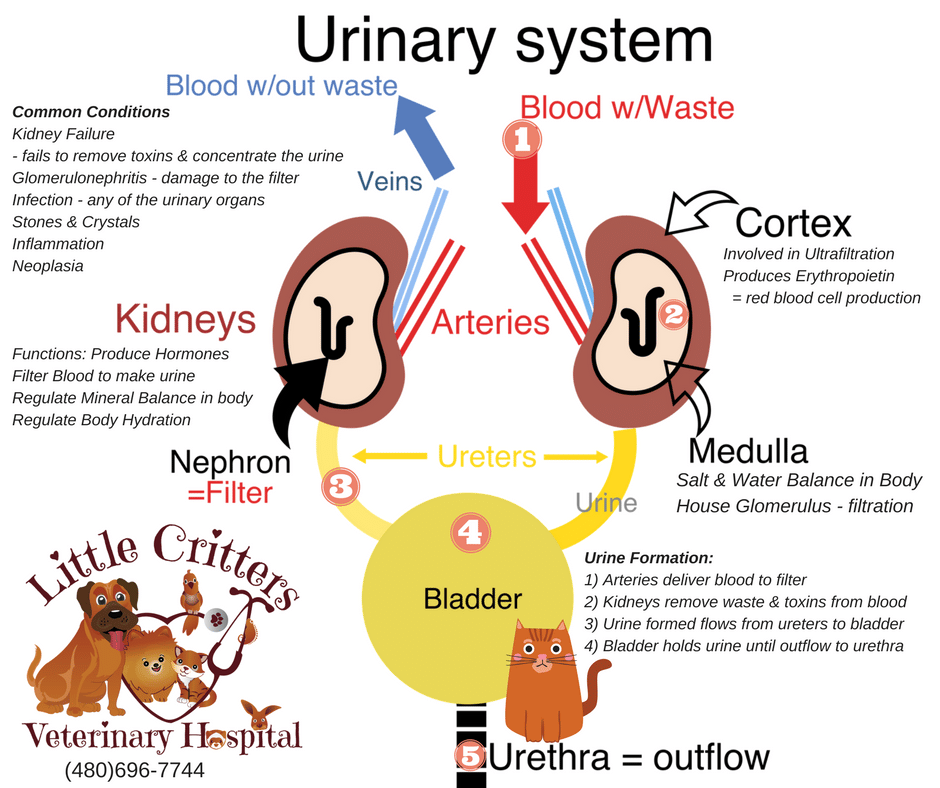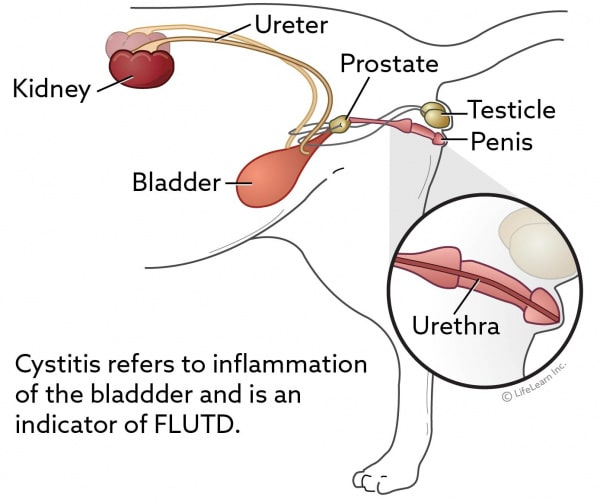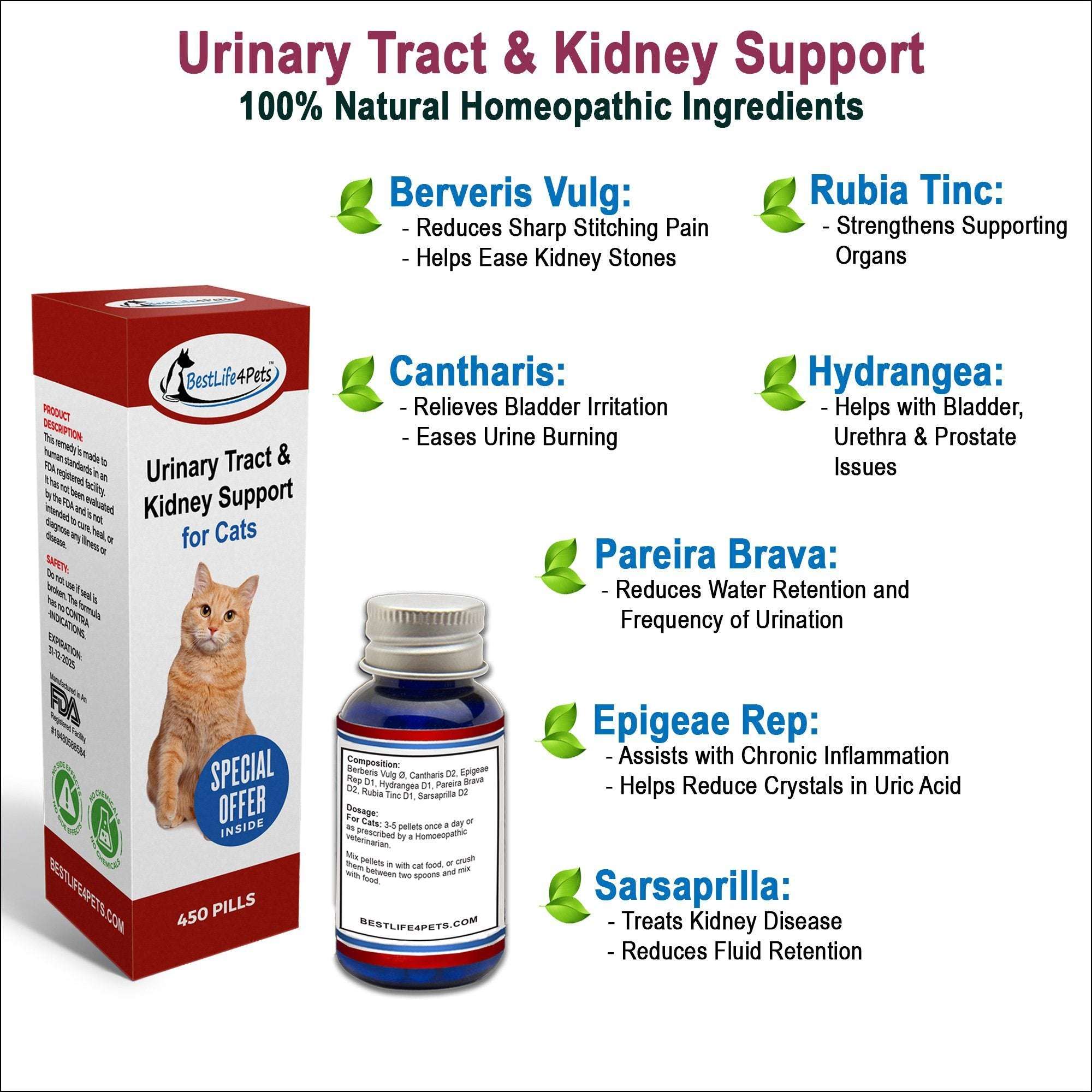What Are The Causes Of Flutd
Urolithiasis
One possible cause of FLUTD is the formation of urinary stones, also called uroliths, in the bladder and/or urethra. These are collections of minerals that form in the urinary tract of cats. X-rays or ultrasound are usually needed to diagnose urinary stones. The most commonly seen uroliths are calcium oxalate and struvite . While a special, stone-dissolving diet can be prescribed to dissolve struvite stones, calcium oxalate stones need to be removed surgically. If the diet fails, or if the stones form again, then surgery may also be necessary for struvite stones. In female cats, it may also be possible for a veterinarian to help a cat pass stones by flushing its bladder with sterile fluids or remove small stones directly from the bladder using a cystoscope when the cat is under anesthesia. A veterinarian may then recommend medication or dietary changes after surgery to help prevent recurrence.
Urinary infection
Infection of your cats urinary tract with bacteria, fungi, parasites or possibly even viruses can cause signs of FLUTD. Although bacterial infections are more common than fungal, parasitic or viral infections, they are still relatively uncommon in cats. If an infection is found, your veterinarian will probably look for another disease or problem that may have put your cat at risk of infection. For example, uroliths and diabetes can increase the risk of urinary tract infection.
Urethral obstruction
Feline idiopathic cystitis
Other causes
How Do You Treat Bacterial Infections In Cats
Infections with pathogenic bacteria are treated with antibacterial treatments. Many infections will require treatment with antibiotics, usually tablets. However, local infections, such as skin, ear, or eye infections, may be treated with topical treatments, such as antibiotic or antibacterial ointments that are applied only to the affected area.
Over the last few years, we are seeing that bacteria are becoming more resistant to antibiotics, meaning that some types of infections are becoming difficult to treat. Antibiotic resistance is very dangerous for humans and animals, and therefore it is vital that antibiotics are only used when absolutely necessary, and that we use the right antibiotics when we do use them.
If your cat is prescribed antibiotics, make sure you use them exactly as your veterinarian has described and ensure you attend follow-up appointments. This will help reduce the development of antibiotic resistance which is vital for future cat health.
Remember, viral infections cannot be treated with antibiotics.
Symptoms Of Feline Urinary Tract Disease In Cats
If your cat has FLUTD or a cat urinary tract infection you may notice one or more of the following symptoms:
- Drinking more water than usual
- Loss of bladder control
- Strong ammonia odor in urine
- Avoidance or fear of litter box
- Hard or distended abdomen
- Excessive licking of genital area
- Cloudy or bloody urine
Also Check: Bulking Injection For Urinary Incontinence
Common Symptoms Of Uti In Dogs & Cats
The signs and symptoms of urinary tract infections are varied. Some dogs with lower urinary tract infections may not even exhibit signs, though most do. The most common signs of dog UTI include:
- Difficulty urinating or straining to urinate
- Hematuria, or bloody urine
- Urine that is cloudy, discolored, or exceptionally smelly
- A frequent need to urinate but in very small amounts
- Breaking housetraining
- Frequently licking the genital area
- Crying out or whining while urinating
Symptoms of cat UTI include:
- Frequent trips to the litter box with very small amounts of urine
- Urinating outside the litter box
- Blood in cats urine
- Straining in the litter box
- Thick, firm, contracted bladder wall, which your
With some cases of urinary tract infection, your cats urethra may be blocked by crystals, stones, or other masses, leading to pain when urinating. Many pet owners mistake this for constipation when the cat is actually dealing with a painful, potentially life threatening issue. In extreme cases when the urinary tract has been completely blocked off, your cat may become depressed and unresponsive or even potentially die.
Detecting urinary tract infections can be difficult. The best thing you can do is to stay observant and take note of any abnormal urinating habits.
Antimicrobial Treatment Of Catheter

Prophylactic antimicrobial treatment is never warranted and no evidence supports routine urine cultures after catheter removal. The 2019 ISCAID guidelines recommend bacterial cultures only in cats with ongoing clinical signs of FLUTD after the catheter has been removed.12
Cats with indwelling urinary catheters and clinical signs of UTI may be difficult to identify as many will have been catheterised for signs of FLUTD initially. Routine cytological evaluation of urine is not recommended as haematuria, pyuria and bacteriuria can occur in the absence of cystitis. Urine cultures should be performed in all cases with suspected bacterial cystitis, in the presence of fever and bacteraemia, and if a sudden change in urine character is seen.12 Because treatment is more likely to be effective if the catheter is removed prior to treatment, the catheter should be removed if possible and urine for culture should be collected by cystocentesis. If the catheter must remain in place, it should be replaced and urine for culture should be obtained through the new catheter.12
You May Like: Irritation In Urinary Tract Male
Things You Can Do Yourself
To help ease symptoms of a urinary tract infection :
- takeparacetamolup to 4 times a day to reduce pain and a high temperature for people with a UTI, paracetamol is usually recommended over NSAIDs such as ibuprofen or aspirin
- you can give childrenliquid paracetamol
- rest and drink enough fluids so you pass pale urine regularly during the day
- avoid having sex
Some people take cystitis sachets or cranberry drinks and products every day to prevent UTIs from happening, which may help. However, theres no evidence they help ease symptoms or treat a UTI if the infection has already started.
Causes Of Bladder Inflammation In Cats
Idiopathic cystitis by definition has no known cause, but there are conditions that felines can have that will cause inflammation of the bladder. Medical conditions such as crystalluria, or the formation of crystals in the urine, as well as environmental factors, can cause cats to experience cystitis.
Causes of feline cystitis can sometimes include:
- Crystals or stones forming in the urine
- Bacterial infection
Recommended Reading: How To Cure A Bladder Infection At Home Fast
Don’t Miss: Medicine To Treat Urinary Tract Infection
The Causes Of Urinary Tract Problems In Cats
FLUTD is an acronym for feline lower urinary tract disease and is one of the most common urinary problems in cats.
The pain comes from the lower urethra and the bladder. There is a number of potential causes for urinary problems in cats to develop. As a cat owner, be cautious about these issues that your feline friends may develop.
Understand what may cause urinary problems in cats. This can help you better understand how to reduce the risk of your cat developing problems with their urinary tract.
Some of the common causes of urinary tract problems in cats include:
Adjusting Your Cats Diet
Read Also: Urinary Tract Infections Utis Antibiotics
Recovery Of Urinary Tract Infections In Cats
Your cats recovery will depend on the underlying cause of the infection. Generally, cats will start to show improvement within 2-3 days of treatment, if the case is not serious.
Always follow your vets treatment instructions. Be sure to provide clean water at all times. Encourage drinking where you can and ensure that litter boxes are clean. This can help reduce your cats stress and may speed up recovery.
Urinary tract infections can be expensive to treat. If you suspect your cat has a urinary tract infection or is at risk, start searching for pet insurance today. Brought to you by Pet Insurer, Wag! Wellness lets pet parents compare insurance plans from leading companies like PetPlan and Trupanion. Find the pawfect plan for your pet in just a few clicks!
Can A Uti Or Kidney Infection Cause Vaginal Bleeding
Ask U.S. doctors your own question and get educational, text answers â its anonymous and free!
Ask U.S. doctors your own question and get educational, text answers â its anonymous and free!
HealthTap doctors are based in the U.S., board certified, and available by text or video.
Dont Miss: Can Anxiety Cause Bladder Leakage
Also Check: Holding Pee Urinary Tract Infection
Bacterial Growth And Susceptibility Testing
Bacterial growth was observed in 5 of 20 urine samples of female cats and in 11 of 41 samples of male cats . Three in five cats with bacterial LUTI were 1 year old or younger, 9/38 27 years old and 4/18 8 years old or older . In this study, no significant difference was found between female and male cats with bacterial LUTI . The differences among age groups were also not significant .
Antimicrobial susceptibility tests results showed that 13 of 16 isolates were susceptible to cefovecin. E. avium and S. epidermidis isolates were resistant and Arcanobacterium renale isolate was intermediate.
Read Also: Urinary Tract Infection Or Kidney Stone
How Is Flutd Diagnosed

Because FLUTD has many causes, it can be difficult to diagnose. Based on your cat’s symptoms, your veterinarian will do a physical examination and most likely will run a urinalysis assessing urine pH and concentration and presence of crystals, bleeding, inflammation and infection. If the cause is still not identified, tests such as urine culture, x-rays, blood work and additional urine tests may be recommended.
Don’t Miss: Is Bactrim A Good Antibiotic For Urinary Tract Infection
Why Does My Cat Keep Getting Uti
If your cat has developed a feline urinary tract infection, there is a good chance that UTI will recur. Urinary tract infection in cats is painful and uncomfortable. Therefore, if your cat keeps getting UTI, you need to do something about it.
One of the main reasons underlying the recurrence of UTI in cats is the unfinished round of antibiotics. This not only leaves some bacteria alive to grow and reproduce but also leads to the development of antibiotic resistance.
Warning Signs And Symptoms Of Urinary Tract Disease
If your cat exhibits any of the warning signs of FLUTD, contact your veterinarian immediately. Especially if your cat is not urinating freely, a urinary blockage may be the cause and this condition may be life threatening. Consult your veterinarian immediately.
Signs of feline bladder health problems
- Urinating outside of the litter box
- Straining when urinating
- Lack of energy or interest in normal activities
Also Check: Male Urinary Incontinence Sheath System
Can Healthy Cat Eat Urinary So
Image Source: salsify
You can feed Royal Canin Urinary SO to any cat, regardless of their age or health. When cats require urinary care, they require it in a nutritionally balanced manner.
House cats frequently have a variety of conditions that cause them to experience urinary or bladder problems. Consuming a cats diet can influence the balance of urinary pH or improve it. Grain-free foods may benefit cats with urinary tract problems as long as they do not contain high carbohydrate foods like potatoes and peas. Alltech Acid Balance lowers the urinary pH in order to prevent bladder stones and struvite crystals. The actogen is a combination of yucca, chicory root, and yeast to promote digestive health. The prescription Diet at Hills c/d Multicare Urinary Care. It is recommended that cats drink a wet cat food to improve their urinary tract health.
A prescription diet is a nutritional recipe that supports a patients chronic or acute health condition. If you want to boost your cats hydration, a premium wet cat recipe, such as Wellness Natural Cat Wet Foods, is a good place to start. Other diets designed to benefit healthy pets are not required to be prescribed by a doctor, according to Lorraine Wilde. Dr. Danielle Bernal, a Global Veterinarian, is the Marketing Director of Wellness Natural Pet Food. During her travels, she speaks with pet parents about the importance of natural nutrition in their animals health.
How To Treat Urinary Tract Infection In Cats
Almost all urinary tract infections can be treated on an outpatient basis. In addition to antibiotics, your veterinarian may recommend an injection of subcutaneous fluids to help rehydrate your cat, as well as a short course of pain medications . Occasionally, if a cat is debilitated or if the UTI has spread to the kidneys , hospitalization may be recommended.
Diet plays a part in treatment and can help prevent additional UTIs. Drinking plenty of water will help flush out the bladder, and get rid of crystals and cellular debris that can lead to the creation of urinary tract stones. If there are excess crystals in the urine, a special diet will be necessary for a few weeks to change the pH of the urine, which will help dissolve the crystals. Once the crystals are gone, talk to your vet about a preventative diet that will prevent the crystals from reforming.
You May Like: Can Enlarged Prostate Cause Urinary Leakage
Symptoms Of Urinary Tract Problems In Cats
Since cats are unable to communicate with their owners in plain English , it can sometimes be hard to know what is wrong with your cat when they start to act differently than usual.
Urinary problems in cats can be painful and very unpleasant for a cat, which is why it is crucial for owners to know about the symptoms of urinary tract problems in cats.
The most common signs that your cat might be experiencing the dreadful effects of FLUTD may include:
- Urine may seem cloudy or even bloody at times.
- When the cat urinates, they might give out a cry due to the pain.
- A cats urine will usually have a strong ammonia smell to it.
- Urine may dribble from the cat due to a loss of control over their bladder.
- The cat may frequently lick the opening of their urinary tract.
- You may notice your cat visits the litter box more frequently the cat may also sometimes squat over the litterbox for prolonged periods of time.
- The cat may seem lethargic.
- Some cats may also vomit when they have FLUTD.
Interpreting Prescription Pet Food Labels
To ensure that the food you give your cat is specifically designed for kidney failure, read the instructions carefully and make sure they are correct. Your other cats may not be able to benefit from this diet, but it is safe. There is little difference between prescription pet food and other brands in terms of price or quality. If you are on prescription food for an extended period of time, it is critical to remember that the food is intended to be fed intermittently and is not recommended for long-term feeding over the age of six months.
Recommended Reading: Urinary Tract Infection In Men Homeopathic Treatment
What Are The Causes Of Uti In Cats
Essentially, urinary tract infections in cats occur when bacteria reaches the bladder by traveling through the urethra of the cat. This is fairly uncommon and UTI in cats might be caused by an underlying disorder, such as Feline Lower Urinary Tract Disease . UTI in cats should be treated by a veterinary professional. They can lead to bladder stones, kidney failure, and additional health disorders.
How Do I Know If My Cat Has A Bacterial Infection

The signs of a bacterial infection in cats vary hugely. It depends on the type of bacteria and where the infection is. However, cats with infections will often show vague symptoms such as a fever, being lethargic or off-color, and reduced appetite, and may lose weight.
If you think your cat is showing signs of an infection it is important that you take them to see your veterinarian as soon as possible, as untreated infections can become very serious.
Don’t Miss: Exercises To Improve Urinary Incontinence
A Healthy Diet Goes A Long Way
Believe it or not, your cats diet can increase or decrease their risk for UTIs. Your vet may suggest that you feed your cat a diet with less minerals these minerals are often found in commercial dry cat food. Consider feeding your cat a canned diet instead of a dry diet. If they prefer dry food, make sure your vet approves the quality and try to mix in a little bit of wet food each day.
While your cat may watch you eat dinner, never feed your feline table scraps.
Recommended Reading: What Antibiotics Treat Bladder Infection